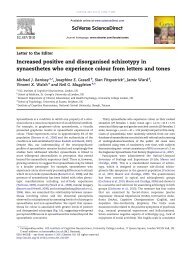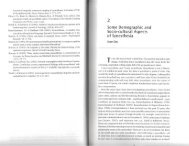A strong parietal hub in the small-world - Synesthesia
A strong parietal hub in the small-world - Synesthesia
A strong parietal hub in the small-world - Synesthesia
You also want an ePaper? Increase the reach of your titles
YUMPU automatically turns print PDFs into web optimized ePapers that Google loves.
Small-<strong>world</strong> network of coloured-hear<strong>in</strong>g synaes<strong>the</strong>tes 185<br />
follow<strong>in</strong>g analyses. This particular threshold (only one for each frequency band) was<br />
applied for each <strong>in</strong>dividual subject.<br />
Regional node analysis<br />
In order to identify and discrim<strong>in</strong>ate important <strong>hub</strong> regions with<strong>in</strong> <strong>the</strong> <strong>small</strong>-<strong>world</strong>,<br />
degree (D) measures were calculated for each <strong>in</strong>dividual node and plotted as degree<br />
distribution (Freeman, 1978; Opsahl & Panzarasa, 2009). Degree (which is a particular<br />
centrality measure) is def<strong>in</strong>ed as <strong>the</strong> sum of weights <strong>in</strong>cident upon a particular node<br />
(i.e., <strong>the</strong> sum of weights of <strong>the</strong> edges connected to a particular node). Therefore, every<br />
node is characterized by its own degree value. To visualize <strong>the</strong> degree values graphically,<br />
MATLAB software (MathWorks, 2007) was used.<br />
Statistical analysis<br />
Because of <strong>the</strong> relative <strong>small</strong> number of subjects and extremely large number of variables,<br />
it is nearly impossible to conduct classical statistical <strong>in</strong>ference test. The reason is <strong>the</strong><br />
<strong>small</strong> power even when <strong>strong</strong> effect sizes are present. Thus, when apply<strong>in</strong>g corrections<br />
for multiple tests (which is necessary to perform statistical tests with large numbers of<br />
variables on <strong>the</strong> same dataset), no or only a few of <strong>the</strong> very <strong>strong</strong> effects would have<br />
been identified. Because of this, we decided to use a different more descriptive statistical<br />
procedure for most of <strong>the</strong> statistical tests. For a subset of bra<strong>in</strong> regions, we performed a<br />
hypo<strong>the</strong>sis-driven statistical analysis (step 3 mentioned below). For <strong>the</strong>se comparisons,<br />
we draw <strong>strong</strong>er conclusions from <strong>the</strong> analyses. For hypo<strong>the</strong>sis-free analyses, <strong>the</strong><br />
statistical test results are not <strong>in</strong>terpreted <strong>in</strong> terms of statistical significance, <strong>the</strong>y are<br />
ra<strong>the</strong>r used as descriptive measures of between-group differences. For <strong>the</strong>se analyses,<br />
we will be more reluctant <strong>in</strong> <strong>in</strong>terpret<strong>in</strong>g <strong>the</strong> f<strong>in</strong>d<strong>in</strong>gs. The p-values for <strong>the</strong>se betweengroup<br />
comparisons can be taken as measures of effect (steps 1, 2, and 4 mentioned<br />
below) (Krauth, 1988). S<strong>in</strong>ce we have to consider <strong>the</strong> fact that p-values depend on<br />
sample size, we also calculated effect sizes accord<strong>in</strong>g to Cohen (1969). A d > .5 is<br />
considered as be<strong>in</strong>g moderate, while a d > .8 is considered as be<strong>in</strong>g large. We will only<br />
comment on effects associated with a p ≤ .05 or a d > .8 (large effect size). For <strong>the</strong><br />
sake of completeness, d and p values will be reported for all analyses (hypo<strong>the</strong>sis-driven<br />
and hypo<strong>the</strong>sis-free). All statistical analyses were performed us<strong>in</strong>g PASW statistics 18 for<br />
MAC. Our statistical analysis comprised <strong>the</strong> follow<strong>in</strong>g steps:<br />
(1) A topographical analysis was performed compar<strong>in</strong>g coloured-hear<strong>in</strong>g synaes<strong>the</strong>tes<br />
with non-synaes<strong>the</strong>tes for each frequency band and each electrode. This analysis was<br />
deemed important to ensure that no general activation differences exist between<br />
coloured-hear<strong>in</strong>g synaes<strong>the</strong>tes and non-synaes<strong>the</strong>tes.<br />
(2) For each frequency band, a between-groups test (synaes<strong>the</strong>tes vs. control subjects)<br />
us<strong>in</strong>g t-test for <strong>in</strong>dependent samples was performed for <strong>the</strong> general <strong>small</strong>-<strong>world</strong><br />
<strong>in</strong>dices (number of edges, density, cluster<strong>in</strong>g coefficient, and path length). Similarly<br />
as for step 1, we did not formulate an explicit hypo<strong>the</strong>sis, s<strong>in</strong>ce <strong>the</strong>re is currently<br />
no data available suggest<strong>in</strong>g a general whole-bra<strong>in</strong> difference with respect to <strong>the</strong><br />
<strong>small</strong>-<strong>world</strong> topology <strong>in</strong> coloured-hear<strong>in</strong>g synaes<strong>the</strong>tes.<br />
(3) Based on our explicit hypo<strong>the</strong>sis formulated <strong>in</strong> <strong>the</strong> <strong>in</strong>troduction of this paper, we<br />
anticipated specific network features <strong>in</strong> three bra<strong>in</strong> areas, which are hypo<strong>the</strong>sized to<br />
be pivotal for coloured-hear<strong>in</strong>g synaes<strong>the</strong>tes: <strong>the</strong> <strong>parietal</strong> cortex, <strong>the</strong> fusiform gyrus,<br />
and <strong>the</strong> auditory cortex. S<strong>in</strong>ce hyperb<strong>in</strong>d<strong>in</strong>g and cross-activation are implicated<br />
with synaptic strength and thus <strong>the</strong> number of connections, <strong>the</strong> degree measure is




